The outbreak we (unfortunately) needed to have to force a paradigm shift away from COVID Zero
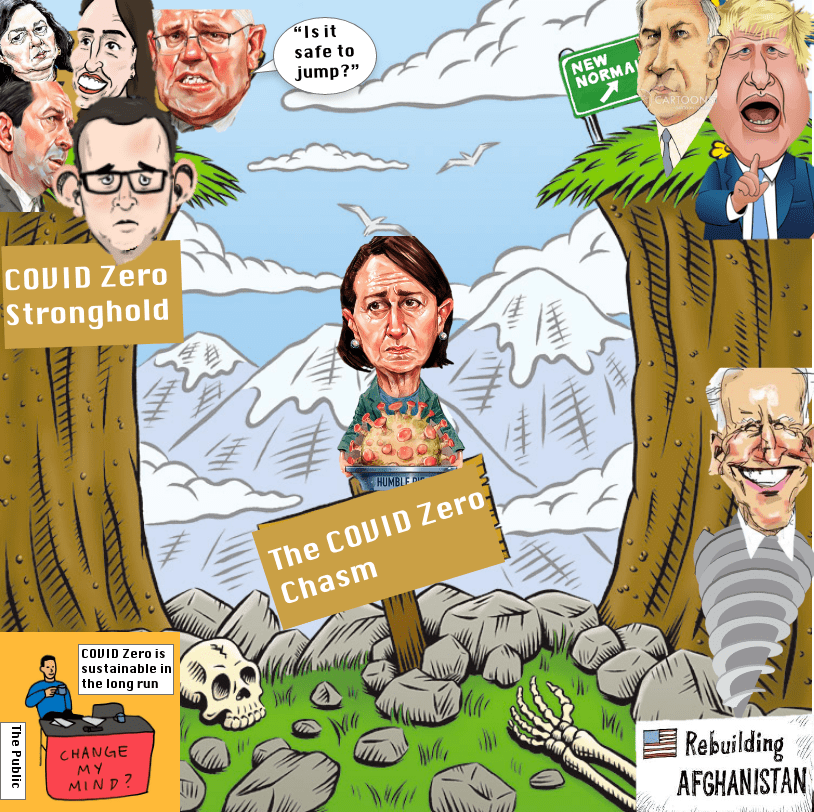
In this essay I am going argue that whilst the Sydney outbreak was earlier than we would have liked, to move to a post-COVID normal, such an outbreak is perhaps necessary and inevitable. Without community transmission, politicians, public health officials, media, and especially the public of a “COVID Zero nation” perceive the risk of COVID as abstract. Such behaviour leads them to enact policies and reward behaviours consistent with COVID Zero. Doing so means that they are never quite ready to accept community transmission willingly, and the day-to-day risk of an outbreak compounds into a certainty. The bittersweet news, as I will show, is that this final outbreak is the last leg of the COVID journey. Once the idea of COVID Zero becomes impossible (e.g., NSW), this forces a paradigm shift into the new normal of a post pandemic world.
Sydney is now 8 weeks into lockdown. The outbreak has spread to Victoria, the ACT and even New Zealand. Many in our media and political landscape - especially those with a distrust of Gladys Berijiklian - maintain this is the lockdown “we did not need to have”.
If only we had continued imposing “short and sharp” lockdowns before cases even had the opportunity to spread, NSW would remain a COVID free utopia. As the Pfizer supply came in, we would all get vaccinated and all COVID would be a thing of the past.
The Pfizer supply would sooth other ailments too; away from COVID Zero expectations; zero infections, zero deaths, during a pandemic which has ravaged much of the world - at least so we hoped.
At the time of the outbreak, June 26, there was barely talk of any form of an exit plan. The implicit assumption was that we should have “very high vaccination rates” before we can “even discuss” how we would open our nation.
Data from the UK and the US indicating deaths, even with highly vaccinated populations, was not talked about. This was another implicit assumption of our "she'll be right" attitude that we would figure it out. Our pandemic response had been "world-class" up to this point and would continue to be so.
Whilst we now have a significantly clearer exit strategy, let us not forget the situation that was before this recent outbreak. Vaccination rates were non-existent, exit plans were not on the table, the timeline for Australia was extremely uncertain. We had a “freedom” that could be taken away at any time.
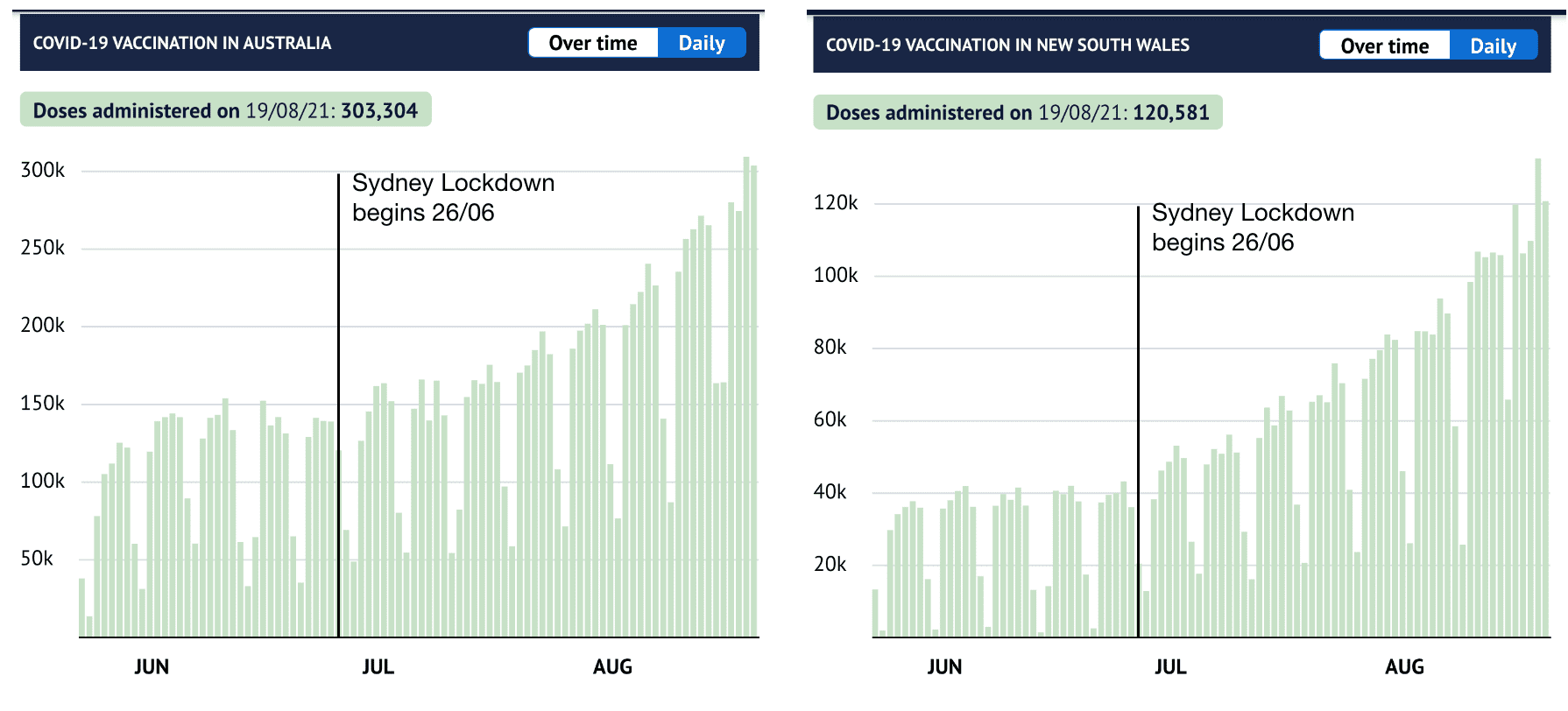 Figure 1: Australia's (left) and NSW (right) vaccination rates before and after this outbreak and lockdown began. A similar pattern appears for Melbourne and some of the other states, but less so. The combination in increased incentive, changes of attitude to AstraZeneca and supply deals from the government has propelled NSW vaccination rates into the stratosphere. We are no vaccinating faster than the UK or the US ever did, only rivalled by Canada.
Figure 1: Australia's (left) and NSW (right) vaccination rates before and after this outbreak and lockdown began. A similar pattern appears for Melbourne and some of the other states, but less so. The combination in increased incentive, changes of attitude to AstraZeneca and supply deals from the government has propelled NSW vaccination rates into the stratosphere. We are no vaccinating faster than the UK or the US ever did, only rivalled by Canada.
Scott Morrison and most state leaders were unwilling to take the risk and shift opinions on community transmission. Changing political beliefs is hard, and Morrison largely just follows polls in a risk-averse manner. For him to stick his neck out and shift public opinion away from COVID Zero would be a huge political risk.
Then came the unravelling.
Our magical “exit plan” was thrown into disarray after Gladys Berijklian waited too long to lockdown. If only she had the guts to stand up to big business and locked Sydney down "properly" - we would have had a "short and sharp" lockdown and we would be living with our “freedoms” intact! That those freedoms could be taken away at the drop of a hat was a sacrifice many were willing to make.
Ignoring the obvious false dichotomy, the generally accepted plan at the time was that as our governments took their time to get their affairs in order, citizens could at least live freely with zero cases in the community. Australians were patient, and if you even hinted at anything diverging from the official suppression policy (elimination - COVID Zero) you would be called a lunatic or someone “on the fringes of society”.
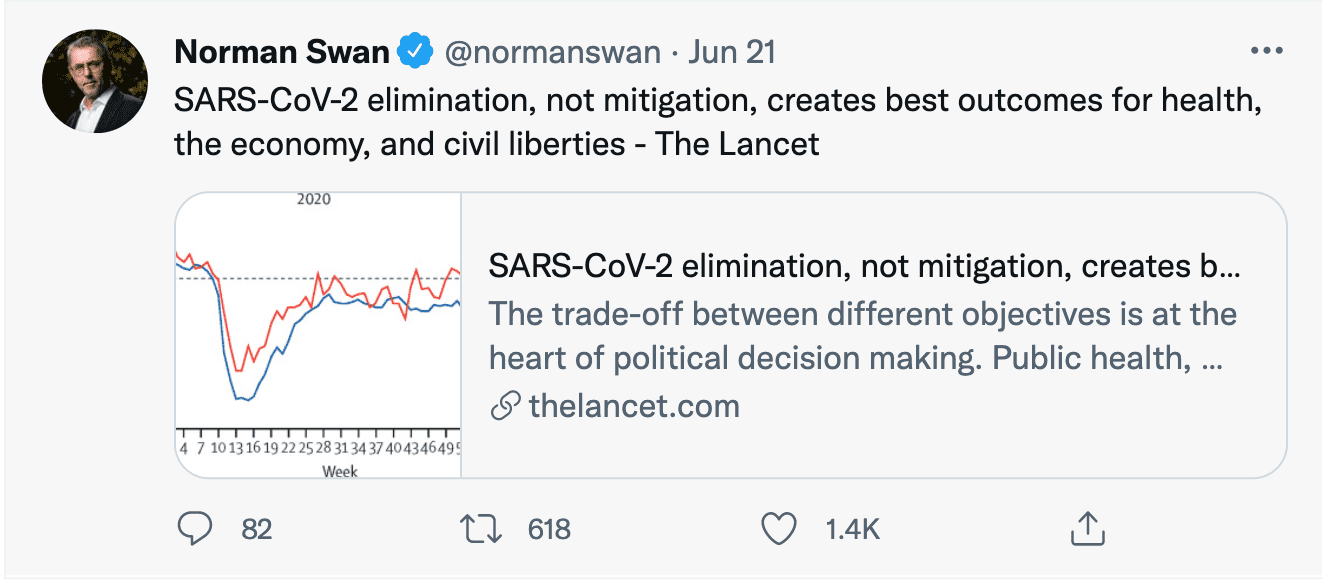 Figure 2 - Example of the elimination policy which dominated public opinion before the outbreak. Many still believe it is not a good idea to have COVID circulating in the community at all. The Doherty Institute report assumes only 30-40 cases a day, and the official advice is we would need to go back to very close to zero before we can open up.
Figure 2 - Example of the elimination policy which dominated public opinion before the outbreak. Many still believe it is not a good idea to have COVID circulating in the community at all. The Doherty Institute report assumes only 30-40 cases a day, and the official advice is we would need to go back to very close to zero before we can open up.
The rose-coloured glasses of hindsight
Now let me pose a difficult question to you, how accurate is this alternative universe?
Would we have completed the laundry list of requirements for us to open safely within the next 6-12 months if we were able to maintain ZERO cases of community transmission?
90% of the population at this stage were living normal lives - except for our palpable isolation from the rest of the world and a few small caveats such as getting tested. Our economy is globally connected but largely can function without needing to move people physically in and out.
I don’t just mean getting vaccination rates to the 80% of the eligible population.
I mean every single policy and behavioural change required to open up to the rest of the world with only minor obtrusions in our day to day lives remaining.
To get Australia to the point where the PM or the Premiers say, “tomorrow we are removing all restrictions and they aren’t coming back" and willingly accept community transmission. If there was no slip in quarantine, how long would this have taken? If our quarantine facilities were bulletproof - like what perhaps would have been provided if the federal government built them - would it ever have happened?
I believe it to be very likely that the only way COVID Zero nations (such as Australia) can re-join the rest of the world, is to fall victim to an accidental outbreak. It is also quite likely for such outbreaks to occur before said countries are ready. The long tail of vaccinations, complacency over time, leaky hotel quarantine and the highly infectious nature of the delta variant means that it will consistently enter COVID Zero nations before they are ready, and there is little they can do to stop it.
In other words, the NSW outbreak and lockdown are not in vain. Perhaps arrived sooner than we would have liked, though perhaps an outbreak in a COVID Zero nation is a self-fulfilling prophecy. We vaccinate too slowly, the risk of an outbreak compounds constantly and only once an outbreak occurs and we feel the brunt of its outcomes (in the form of lockdowns, hospitalisations, and deaths), we finally act to move forward.
I speculate in 3-5 years when we study how different nations exited the pandemic, and unfortunately, very few candidates remain (New Zealand, maybe Taiwan depending on your definitions), no medium to large liberal democracy (5M+) will be able to “exit” the coronavirus pandemic without some period of community transmission and likely death - spurring them on to vaccinate their way out and create a society resilient enough to “live with COVID”.
Whilst this may be a technical detail of some sort - to me, it represents a silver lining to the current outbreak and indefinite lockdowns we are now experiencing. It appears they were in large part required to get us “out” in a reasonable timeframe. Almost a necessary chasm to cross over to post COVID land which every nation must cross eventually. Our effective response in 2020 bought us vaccines and spared many lives, but we did not avoid the “COVID Zero chasm” altogether.
What is the "COVID Zero Chasm" ?
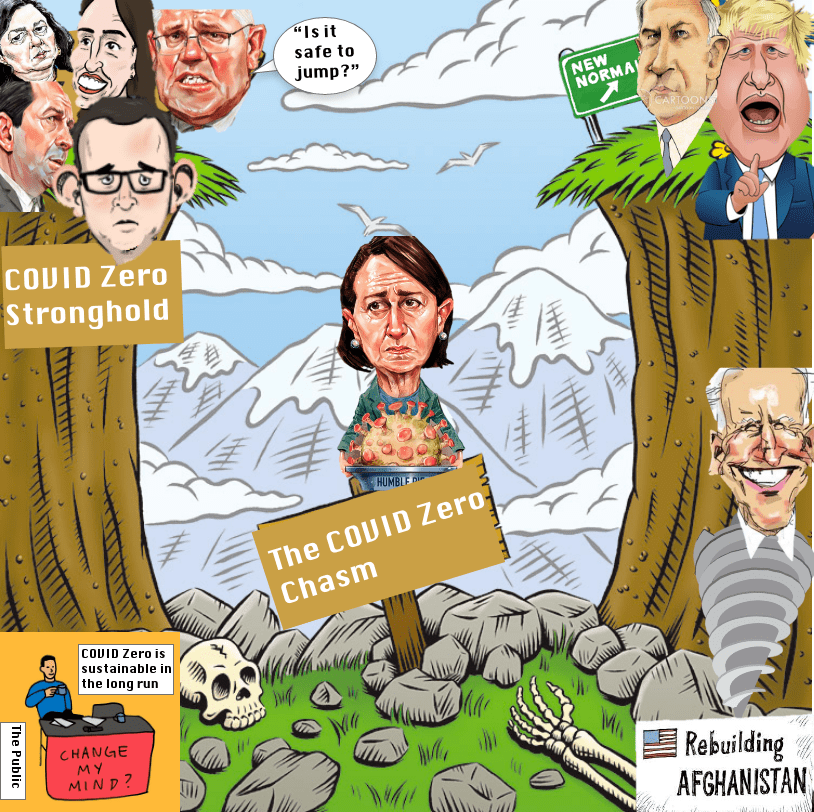 Figure 3 - Gladys Berijiklian crossing the COVID Zero Chasm, and paying a price for it. Politicians are rewarded handsomely for keeping case numbers as close to zero as possible, and exponential growth means COVID Zero expectations make for a formiddable political obstacle to progress.
Figure 3 - Gladys Berijiklian crossing the COVID Zero Chasm, and paying a price for it. Politicians are rewarded handsomely for keeping case numbers as close to zero as possible, and exponential growth means COVID Zero expectations make for a formiddable political obstacle to progress.
I suspect the scale of societal mobilisation required to "live with" COVID-19 is too large to overcome without the underlying risk of catching the virus in the community. A nation will rarely be ready without some cases in the community pushing them through the last few hurdles.
The NSW outbreak serves as an imperfect natural experiment which has forced our hand to forge ahead into the post-COVID world. Here is my “probably wouldn’t have happened without cases and lockdowns list”:
- ATAGI likely would not have changed the advice for AstraZeneca (AZ), meaning over 60s still would be the only ones to access it.
- Walk-in vaccination hubs, pharmacies and GPs would still be unable to administer AZ - and likely would not have been established yet due to the lower Pfizer supply.
- Public perception of AZ would remain where it was before the outbreak, in the gutter.
- Vaccination rates would be dependent only on Pfizer shipment arrivals, which would likely have been even more strained by those able to get AZ (>60) who would have preferred Pfizer due to the poor reputation of AZ. Right now, almost 40% of vaccinations are AZ and almost 50% of those are people under 40 - not to mention under 60.
-
Vaccination rates likely also would be lower generally, due to the lack of consequences for not getting vaccinated anytime soon.
- Before the NSW outbreak, we were moving along at approximately 225,000 doses per week - 0.55% of the total doses to fully vaccinate 80% of eligible Australians. At such a rate it would have taken Australia another 149 weeks (3 years) to fully vaccinate our population.
- Of course, vaccination rates would have sped up with increased Pfizer supply but by how much? It would not be accurate to compare the vaccination rates of COVID infested nations, our incentive structures are much lower. We recently vaccinated 309,000 Australians in a single day - would this have been achieved yet or at all?
- The deal to accelerate Pfizer shipments for 2021 likely would not have occurred, and Australia would not have made a deal with Poland for an additional 1 million Pfizer doses before September
- It is very likely the modelling from the Doherty institute would have been delayed, or perhaps not completed yet at all. The 4-stage plan from the government would have faced a similar fate
- There would have been no renewed push for aged care workers to get vaccinated, resulting in a mandate. Which other essential workers or parts of society have been rushed to vaccination status as a result of the danger?
- Businesses, legal experts, and the government would not yet have begun considering the legal intricacies and ethical dilemmas of mandatory vaccinations. It’s very unlikely businesses such as Qantas, SPC or the NSW government (health workers) would have created mandatory vaccination policies.
- Travel caps would likely have remained at pre outbreak levels. The very few who needed to travel in and out of Australia would still be able to do so without costs equating to first home deposits we face now.
- Australians overseas at this point would have been less able to garner media attention, businesses would have been able to settle slightly a few more skilled immigrants and other visa holders would have been able to continue trickling in.
- The AU-NZ travel bubble would have remained open, further relaxing pressures for borders to reopen as the most popular travel destination for Aussies even in normal times.
- There would have been no pressure on ATAGI to produce guidance on vaccinations for kids - it likely would have lagged regulatory agencies just like it has in approving vaccines.
This list can go on and is far from comprehensive, but the pattern is clear. The NSW outbreak conjured most aggressive campaign to fight COVID since the pandemic began. With a response that is sustainable in the long term. Some may take the view that these things would have happened “anyway” - I ask those people - why didn't it happen in the 6 months preceding the outbreak. The rest of the world completed many of these feats - but we were stuck in COVID Zero limbo.
We often talk about carrots and sticks, the stick of getting infected is a powerful agent of behavioural change. We suddenly rush to get vaccinated, regulatory groups (such as TGA/ATAGI) reassess their risk levels - we even reassess our personal risk levels for getting vaccinated. I will be receiving my second AZ dose soon, along with many Australians who would not have considered doing so if it were not for this outbreak. What about you? Politicians face large drops in public support during an outbreak, spurring on action that is of an urgency we would likely not see otherwise.
Our media landscape is drastically transformed - suddenly there is little else you will see across the front pages of our newspapers and TV. We are discussing how we can reopen, when we might do so, the incredible burden of lockdowns. In February and March of this year whilst other countries were looking to open, with their media focused squarely on how to do so, the biggest issue in Australia was whether Google and Facebook should pay Rupert Murdoch for links.
The accidental outbreak and extended lockdown also provided politicians with an opportunity to begin the task of changing public opinion. For Morrison and most state premiers to have said in a COVID Zero Australia that “it’s time we live with the virus” would have been very politically risky. They would have been seen as cruel and probably called “granny killers” or worse. In March when Berijiklian called for a reduced focus on infections and rather hospitalisations and deaths, and you could hear crickets in the rest of Canberra. Morrison also called Virgin CEO Jayne Hrdlicka insensitive for similar comments and backed away fast.
Infections, prolonged lockdowns, and deaths force nations to “fight” instead of waiting it out
There is something to be said for countries that had community transmission after the point at which vaccines passed clinical trials. They moved quickly, granting emergency authorisation from their regulatory agencies and mobilised their public health systems to deliver vaccines. It makes absolute sense - they were in a crises mode and vaccines were essentially the silver bullet.
Australia approved Pfizer 6 weeks after the FDA and AstraZeneca almost 7 weeks after the UK. By the time our regulatory agencies were finalising the paperwork, the US, UK and many other countries were delivering millions of jabs a day. Israel was able to secure a deal for Pfizer for its entire population in exchange for data - why was the pressure on Scott Morrison for such deals non-existent? Financial status and political organisation are of course also strong determining factors - but is it an accident that on June 26 the UK had 49% of its population fully vaccinated, and in Australia, we had 4.6%?
The curious case of New Zealand
If New Zealand can move into a post-COVID normal without an outbreak, then my argument is not correct, and represents an interesting test case. Some may argue other states in Australia will be able to do this, but they have benefited enormously from the NSW outbreak in terms of making progress to move past COVID Zero – even as Premiers Dan Andrews and Mark McGowan are hesitant to speak to the end of COVID Zero.
Will New Zealand be able to vaccinate 80% (or higher) of its population before community spread occurs? Jacinda Ardern seems determined for it to be so. Singapore may offer an example, even without “uncontrolled” community spread, low levels of cases in the community (however, not zero and this is a key distinction) pushed them to 70% vaccination rates.
I'm sure psychologists and behavioural economists from all around the world will be watching to see. Will the abstract risk of COVID in a COVID Zero nation be enough incentive to get vaccinated? Will the sense of civic duty of 80% of New Zealanders be enough despite not nearly 80% of New Zealanders being affected in their current circumstances? Or maybe the threat and reality of yo-yo lockdowns will be enough.
Over time breaches of quarantine is almost a certainty. As someone pointed out to me, the flip side of this perspective is that government incompetence is guaranteed. If governments acted perfectly, and citizens complied perfectly, a nation could exit COVID-19 without pain. I suggest this is unrealistic, and the number of things that need to go perfectly are so high, failure at some point is guaranteed.
Another consideration is that the cost of maintaining a COVID Zero strategy appears to be increasing as the world moves into “living with” COVID - the high of delta means lockdowns drag on for longer and have less momentum required to get out of control.
Perhaps all the craziness of what’s happening with their neighbour across the Tasman is enough to spur on vaccination rates and serve as incentive enough. Ultimately there exists a dynamic whereby a population needs to get a high level of vaccine coverage before “allowing” COVID to spread in the community, but without COVID in the community incentives for vaccines are low.
One can almost think of climate change as an analogy. The threat is very real and scientifically validated, but abstract in the sense that it’s not here now, affecting our day-to-day lives and leads most people to continue to avoid risk reduction methods or focusing on the wrong goal.
On the other hand, COVID Zero nations also need to have higher levels of vaccinations - we have no natural immunity. Thus 61% fully vaccinated in the UK looks very different to 61% in Australia. Someone much smarter than me probably would be able to work out the maths for an equilibrium point - where the ongoing risk of community spread from hotel quarantine, the level of COVID Zero vaccine coverage (inversely health outcomes) and the need to minimise the length of the final quarantine all reach an equilibrium point. Sydney is likely early on the vaccine coverage curve, meaning we will need to spend almost 4 months in lockdown since we did not adequately protect from the low risk of community spread. The “final lockdown” is probably inevitable, but you want to do it whilst vaccination rates have plateaued, and supply is available.
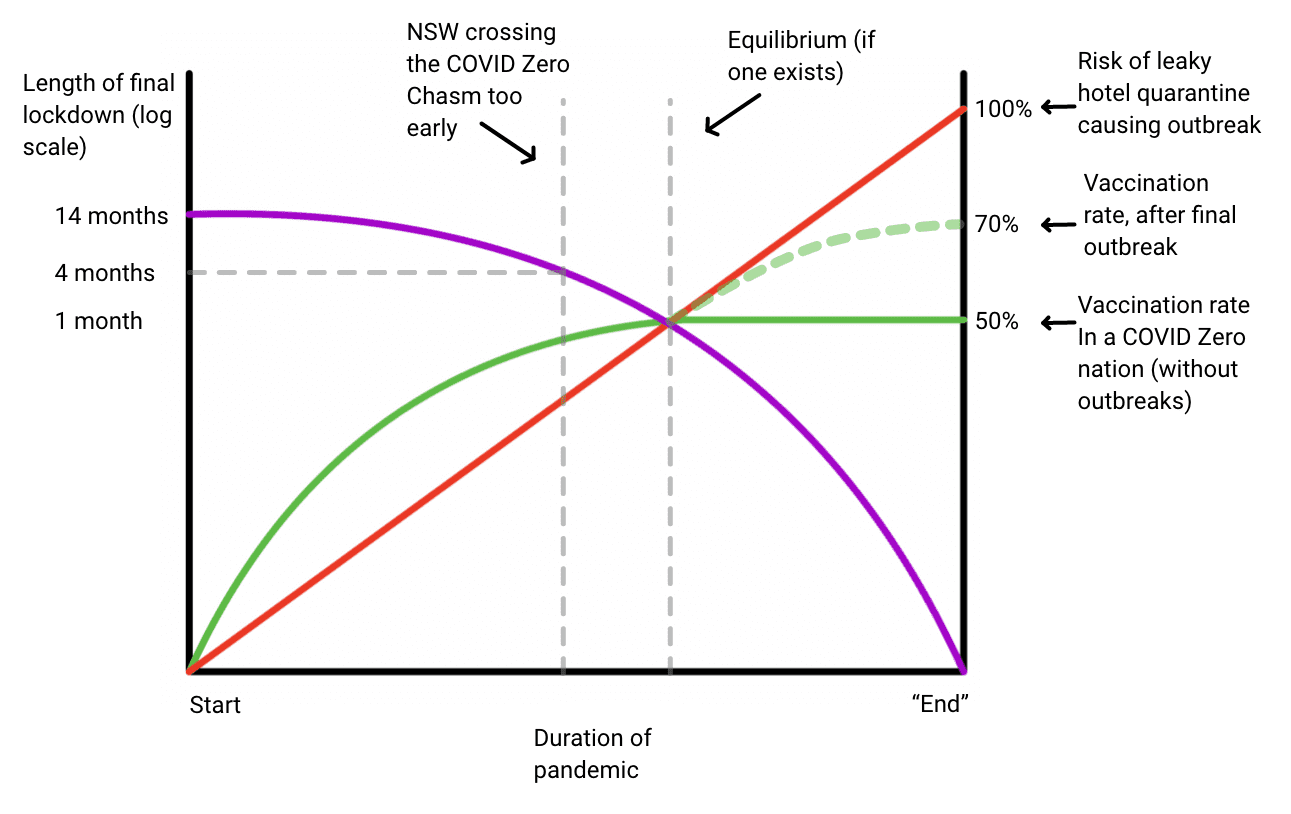 Figure 4 - Illustrative graph showing dynamics of the "COVID Zero Chasm". Scale is not important :)
Figure 4 - Illustrative graph showing dynamics of the "COVID Zero Chasm". Scale is not important :)
Escaping COVID Zeroism
This essay is not meant to absolve any politicians of their failures over the last year, nor is it meant to degrade the strategy of lockdowns. The complacency brought on by not having a disease in the community is unhelpful, and there is very little justification for “taking our time” rolling out vaccines. The deaths of your citizens are only one outbreak away and a sense of urgency is necessary regardless of your current situation.
I also want to remind those in Australia that these lockdowns are not in vain. Not only are they saving immeasurable lives, but they are also moving us forward to fight the reality of COVID.
COVID Zero is a mentality that is not only unrealistic but also not conducive to long-term thinking. The longer we continue to believe COVID Zero is possible, the more likely we are to put policy frameworks in place which advance that cause; strategies focused on keeping COVID out, instead of strategies focused on reducing the spread and saving lives. The latter is undeniably more important since those policies matter more when outbreaks eventually occur, not if.
Moving on from COVID Zero is a mental leap we were going to have to make at some stage - and it was always going to be painful. Largely Australia should be proud of the lives we saved by working together and making sacrifices for each other. The future is largely optimistic, dot not bother with those only interested in the future problems we face.
We are no longer stuck in limbo; COVID Zero was a stasis, a temporary holding period at best. If we stayed in purgatory too long it likely would have affected us negatively too. How long can you make your citizens live under the stress of a stay-at-home order at any time? How many lockdowns would it take? What if a new variant comes, or delta becomes more infectious requiring, even more, yo-yo lockdowns?
How long can you keep the 30% or so of Australians born overseas away from their families? The growth opportunities we are foregoing, both economically and socially, by staying in Fortress Australia compound over time.
The impact on our culture, our mental health and the development of young people is not to be underestimated. We cannot vaccinate our way out of the myriad of mental health problems caused by these impositions of stress, isolation, and sacrifice.
We are moving, ready for what comes next. Progress and a post-COVID future await.
As I write this, today Gladys Berijiklian said the words which perfectly summarises the unfortunate reality facing NSW and all other COVID Zero nations. History may not be kind to Berijiklian for letting it slip too early.
The fate of Berijiklian now hangs in the balance of how quickly NSW can get to the other side. Newspapers today are awash with theories, ideas, and questions that we need to answer to “live with COVID”. Some are even questioning the official elimination-until-70%-vaccinated policy. The penny has dropped, and the slow-moving beast of public opinion is on the move.
If NSW can "live freely" long before the other states, perhaps Berijiklian will be rewarded politically for her steadfast line of vaccinating NSW out, and in truth, her leadership to be the first to tell Australians the difficult truth that we had coming, about the “COVID Zero chasm” we needed to cross:
“Every state is going to have to confront the prospect” that “we can’t live in our bubble forever”
“Of course NSW, because of our situation, is confronting this challenge earlier than what we had hoped we would, but … every state has to live with the fact that once you get to 80% double doses and your population is allowed to live more freely, that the Delta variant will creep in.
“These are the difficult decisions that our nation has to deal with, but to assume that forevermore there will be zero cases around Australia is, I think, an assumption nobody can really make at this stage,” she said.
“We do need to coexist with Delta” - G. Berijiklian
Footnotes
1. A COVID Zero nation is characterised by long periods of zero community transmission, in which the public live relatively ordinary lives with few impediments with the exception of international travel. (e.g., New Zealand, Australia before the outbreak) In an ideal COVID Zero nation, lockdowns are infrequent and short lived. Such a nation would need to open their borders and make a conscious decision to allow community transmission.
2. Here I assume containing delta was possible if we locked down sooner - but perhaps this is a tenuous assumption given how much NZ and Victoria are struggling to stamp out the embers of community transmission.
3. Here “open” means properly open. Similar to the border restrictions in place in the US, the UK and most of Europe. Not open with 2-week isolation requirements at “Centres for National Resilience” (quarantine)
4. Meaning they have 0 cases most of the time and rare outbreaks. E.g. New Zealand, Australia, Taiwan, China, many island nations
5. The provision of liberal democracy is in place merely because it would be possible to wait multiple years for vaccines that offer very high (97%+ such as measles etc.) protection from infection and transmission, allowing them to achieve herd immunity which is not possible with current vaccines. Or they simply force all citizens to get vaccinated. This is unlikely in a liberal democracy in which its people interact with the rest of the world and will grow impatient but could be forced to comply by authoritarian regimes (e.g., North Korea/China).
6. For a COVID Zero nation, a risk reduction method might be to book only holidays that are refundable, get a job that is unaffected by lockdowns, not have kids, do postgraduate study, avoid going overseas in case you can't get back etc. These methods focus on the goal of living with "COVID Zero" not living with COVID.
7. An example of the complacency by one of the commonly quoted COVID experts https://www.smh.com.au/national/not-concerned-time-to-stop-worrying-about-the-vaccine-rollout-20210323-p57dc3.html
8. To be clear, this is not an advocation of “let it rip” and has a long-term view in mind. As a related tangent, for those who think death and illness would cause more mental health issues, I firmly disagree. Death and illness have been a part of humanity for far longer than what we are imposing on citizens today, even pandemics have. We are better equipped to deal with those realities.


